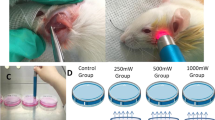Abstract
To investigate the effect of FK506 on apoptosis of facial motor neurons in rats and its possible mechanism. A total of 48 Wistar rats were randomly divided into experimental group and control group. Facial nerve injury model was established by transection of facial nerve at stylomastoid foramen. Rats in experimental group and control group were provided with FK506 and normal saline by intraperitoneal injection, respectively. The morphology of facial neurons was observed under light microscope at different time points after injury. Apoptotic facial motor neurons were detected by TdT-mediated dUTP-biotin nick and labeling (TUNEL) staining, and expression of bcl-2 and bax was evaluated by immunohistochemistry. After facial nerve transection, the apoptotic cells in experimental group significantly decreased compared to control group (P < 0.05), with higher expression of bcl-2 and lower expression of bax in experimental group. FK506 could inhibit apoptosis of facial motor neurons after facial nerve transection, possibly via up-regulation of bcl-2 expression and down-regulation of bax expression.




Similar content being viewed by others
References
Hohman MH, Bhama PK, Hadlock TA (2014) Epidemiology of iatrogenic facial nerve injury: a decade of experience. Laryngoscope 124(1):260–265
Dew LA, Shelton C (1996) Iatrogenic facial nerve injury: prevalence and predisposing factors. Ear Nose Throat J 75(11):724–729
Fisch U (1974) Facial paralysis in fractures of the petrous bone. Laryngoscope 84(12):2141–2154
Coker NJ, Kendall KA, Jenkins HA, Alford BR (1987) Traumatic intratemporal facial nerve injury: management rationale for preservation of function. Otolaryngol Head Neck Surg 97(3):262–269
Lambert PR, Brackmann DE (1984) Facial paralysis in longitudinal temporal bone fractures: a review of 26 cases. Laryngoscope 94(8):1022–1026
Humphrey CD, Kriet JD (2008) Nerve repair and cable grafting for facial paralysis. Facial Plast Surg 24(2):170–176
Park OH, Lee KJ, Rhyu IJ, Geum D, Kim H, Buss R, Oppenheim RW, Sun W (2007) Bax-dependent and -independent death of motoneurons after facial nerve injury in adult mice. Eur J Neurosci 26(6):1421–1432
Sato T, Hanada M, Bodrug S, Irie S, Iwama N, Boise LH et al (1994) Interactions among members of the bcl-2 protein family analyzed with a yeast two-hybrid system. Proc Natl Acad Sci USA 91(20):9238–9242
Snyder SH, Lai MM, Burnett PE (1998) Immunophilins in the nervous system. Neuron 21:283–294
Sharkey J, Butcher SP (1994) Immunophilins mediate the neuroprotective effects of FK506 in focal cerebral ischaemia. Nature 371(6495):336–339
Magnain C, Augustinack JC, Reuter M, Wachinger C, Frosch MP, Ragan T et al (2014) Blockface histology with optical coherence tomography: a comparison with Nissl staining. Neuroimage 84:524–533
Rosenwasser RH, Liebman E, Jiménez DF, Buchheit WA, Andrews DW (1991) Facial reanimation after facial nerve injury. Neurosurgery 29(4):568–574
Faris C, Lindsay R (2013) Current thoughts and developments in facial nerve reanimation. Curr Opin Otolaryngol Head Neck Surg 21(4):346–352
White H, Rosenthal E (2013) Static and dynamic repairs of facial nerve injuries. Oral Maxillofac Surg Clin North Am 25(2):303–312
Xu QG, Forden J, Walsh SK, Gordon T, Midha R (2010) Motoneuron survival after chronic and sequential peripheral nerve injuries in the rat. J Neurosurg 112(4):890–899
Kitahama M, Okamoto H, Koseki Y, Inoue E, Kaneko H, Taniguchi A et al (2010) Efficacy and safety of tacrolimus in 101 consecutive patients with rheumatoid arthritis. Mod Rheumatol 20(5):478–485
Emiroglu R, Ayvaz I, Moray G, Karakayali H, Haberal M (2006) Tacrolimus-related neurologic and renal complications in liver transplantation: a single-center experience. Transplant Proc 38(2):619–621
Butcher SP, Henshall DC, Teramura Y, Iwasaki K, Sharkey J (1997) Neuroprotective actions of FK506 in experimental stroke: in vivo evidence against an antiexcitotoxic mechanism. J Neurosci 17(18):6939–6946
Guo X, Dawson VL, Dawson TM (2001) Neuroimmunophilin ligands exert neuroregeneration and neuroprotection in midbrain dopaminergic neurons. Eur J Neurosci 13(9):1683–1693
Jost SC, Doolabh VB, Mackinnon SE, Lee M, Hunter D (2000) Acceleration of peripheral nerve regeneration following FK506 administration. Restor Neurol Neurosci 17(1):39–44
Lee M, Doolabh VB, Mackinnon SE, Jost S (2000) FK506 promotes functional recovery in crushed rat sciatic nerve. Muscle Nerve 23(4):633–640
Yeh C, Bowers D, Hadlock TA (2007) Effect of FK506 on functional recovery after facial nerve injury in the rat. Arch Facial Plast Surg 9(5):333–339
Nuñez G, Clarke MF (1994) The bcl-2 family of proteins: regulators of cell death and survival. Trends Cell Biol 4(11):399–403
Wang ZM, Dai CF, Kanoh N, Chi FL, Li KY (2002) Apoptosis and expression of bcl-2 in facial motoneurons after facial nerve injury. Otol Neurotol 23(3):397–404
Deckwerth TL, Elliott JL, Knudson CM, Johnson EM Jr, Snider WD, Korsmeyer SJ (1996) Bax is required for neuronal death after trophic factor deprivation and during development. Neuron 17(3):401–411
Oltvai ZN, Milliman CL, Korsmeyer SJ (1993) Bcl-2 heterodimerizes in vivo with a conserved homolog, bax, that accelerates programmed cell death. Cell 74(4):609–619
Stadelman C, Mews I, Srinivasan A, Deckwerth TL, Lassmann H, Brück W (2001) Expression of cell death-associated proteins in neuronal apoptosis associated with pontosubicular neuron necrosis. Brain Pathol 11(3):273–281
Conflict of interest
None.
Author information
Authors and Affiliations
Corresponding author
Rights and permissions
About this article
Cite this article
Zhang, Y., Zhang, R., Qiao, S. et al. Effect of FK506 on apoptosis of facial motor neurons in rats and its possible mechanism. Eur Arch Otorhinolaryngol 273, 601–606 (2016). https://doi.org/10.1007/s00405-015-3591-z
Received:
Accepted:
Published:
Issue Date:
DOI: https://doi.org/10.1007/s00405-015-3591-z




